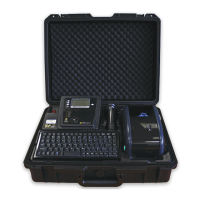25
TnP-500 User Manual Wavecom
Technical Information
Visual Inspection
Visual inspection has to be done before any other test is carried out using any of the range of TnP-500 appliance testers.
The visual inspection is carried out to ensure there are no physical faults with the appliance before testing.
The following list is an example of potential physical faults, but it is not exhaustive and the relevant standards
must be consulted to ensure a proper Visual Inspection is undertaken.
• There is no damage or component defects to the accessories, plugs, outlet sockets or connectors (physical).
• There are no cracks or abrasions.
• There are no exposed inner cores or conductors (flexible) and the supply cords are not twisted or distorted.
• Any Fuse/Overload protection components (if fitted) are checked.
• All labels, markings and warning indicators (of the maximum load to be connected to the device) are
legible and intact.
• The insulation is not damaged in any way i.e. melted, cuts or abrasions. There are no iron filings in the
insulation. There is no insulation tape on the lead.
• Any flexible cords and/or leads are effectively anchored (glands and grommets intact).
• All covers or guards are in place and secure as intended by the supplier/manufacturer.
• All safety devices and systems are in good working order. (i.e. overload latches & buttons).
• No dust or dirt obstructs any exhausts or ventilation outlets.
• All controls are working properly and are secure and aligned.
Important - If Result is a Fail:
If any Equipment fails ANY of the above, it should be deemed to have FAILED the Visual Test, and therefore
no other tests need be performed. If this is the case the Equipment should be tagged with a DANGER TAG
and removed from service. It is recommended by the manufacturer and distributor of this product that it
SHOULD NOT BE RETURNED TO SERVICE. To do so would be considered unsafe.
Class 1 (Earthed Appliance) Construction
Single basic insulated and protectively earth equipment
This type of product design provides two safety barriers between all live conductors at dangerous voltages
and the equipment user. The provision of basic insulation between exposed metal parts and live parts is the
first barrier to provide basic protection against electric shock. The second safety barrier is by the connection
of exposed (accessible) conductive (metal) parts to the protective earthing conductor (earth wire) in the fixed
wiring of the device/Installation.
The protective earthing terminal of the equipment must be marked with the word “earth” or the symbol “E” or
the symbol for Earth Terminal or Protective.
To perform this test, a continuous earth loop must be made between the exposed conductive material (metal)
and the TnP-500 appliance tester. This is done by means of connecting the earth lead with the crocodile
clip/probe attached to a GOOD earth point (paint & coatings will not provide effective connections) and the
appliance plugged into the TnP-500 appliance testers’ test socket. The Maximum allowable limit is less than
1.0Ω.

